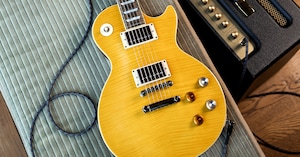New York City was in the midst of a heatwave on July 28, 1952, but it was still possible to ice skate—at least in the Terrace Room of the New Yorker Hotel. While tourists enjoyed the indoor rink, a different crowd gathered six floors above.
The National Association of Music Merchants (NAMM) convention was in full swing, and the Gibson Guitar Corporation had booked five rooms to showcase its acoustics, mandolins, steel guitars and archtops. One room was particularly packed, as industry insiders gathered around a new model: the Les Paul.
There have been many different models of the Les Paul over the years, but they all share the DNA of its namesake. Born Lester William Polsfuss in 1915, this preternaturally gifted guitarist went by "Rhubarb Red," "Hot Rod Red" and "The Wizard of Waukesha" as he wowed audiences with his musical talent.
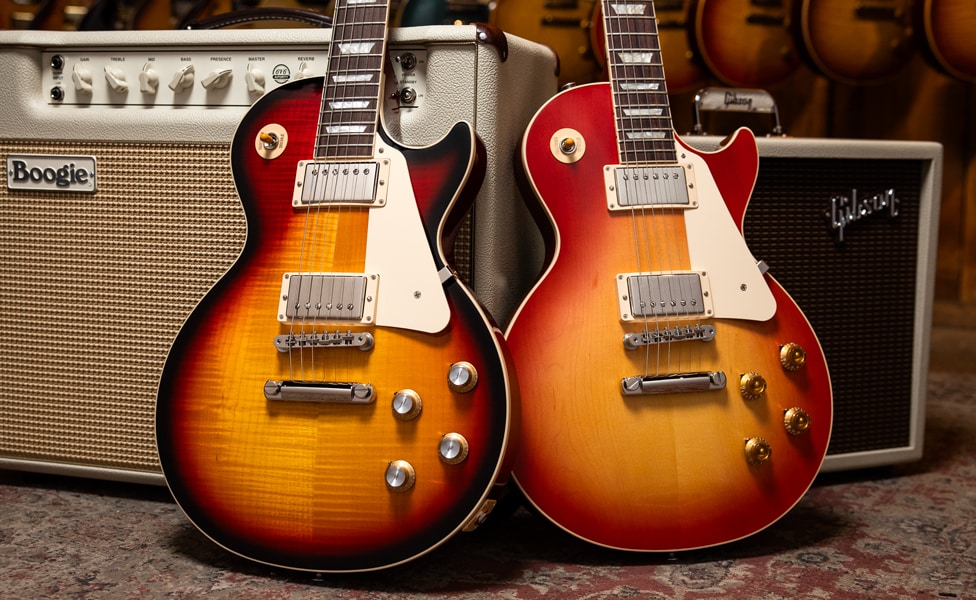
Left: Gibson Les Paul Standard '60s Tri-Burst; Right: Gibson Les Paul Standard '50s Washed Cherry
By 1952, the man now known as Les Paul was selling millions of records and churning out hits with his wife, vocalist and guitarist Mary Ford. He was also skilled electronically, pioneering multitrack recording and other audio innovations. Thrilling audiences with his almost magical experiments using sound-on-sound looping, Paul created an orchestra of sounds with a single guitar that could be heard nationwide on his radio show and seen on his many TV appearances.
At the time, there was no guitar player more famous than Les Paul. What better choice to play, promote and evangelize Gibson’s new solidbody?
Legendary Gibson president Ted McCarty certainly knew the power of celebrity endorsements, and he showed the prototype to Paul and Ford in Pennsylvania, hoping to interest America’s chart-topping guitar and vocal duo to showcase the new model publicly in exchange for revenue participation (Paul reported the royalty rate was five percent). McCarty also wanted to name the guitar after Les Paul and imprint Paul’s name on the headstock.
Paul agreed. But then, everything spun into a vortex of selective memories and comic book-style, alternate universe “origin stories.”
Looking for the perfect Les Paul? Check out our guides to the best Gibson Les Paul and Epiphone Les Paul models.
Table of Contents
The Birth of the Les Paul Model
The High-Class Les Paul Custom
Diversifying the Line: The Les Paul Junior, TV and Special
The Dawn of the P.A.F. Humbucker
The Les Paul Standard Debuts
No More Single-Cutaway Les Pauls
The Les Paul Comes Back
The Norlin Era of Gibson
Changes to the Gibson Les Paul in the Norlin Years
Les Paul Returns With Les Paul Recording Model
The No-Frills Les Paul Studio
Gibson in the Modern Era
An Enduring Legacy
The Birth of the Les Paul Model
“We were watching what Leo Fender was doing in California, and we realized he was gaining popularity in the West,” McCarty recalled for Tony Bacon’s 50 Years of the Gibson Les Paul. “I said, ‘We’ve got to get into that solidbody business.’”
Much like what was going on with that California guitar maker, a team at Gibson was enlisted to design the new solidbody. And, in another parallel to early guitar development at Fender, the recollections of the principals sometimes blur the realities of the happenings at the Gibson factory in 1950–1952. McCarty figured there may have been four key figures on the design team: himself, Gibson Vice President in Charge of Production John Huis, an unnamed guitar player in final assembly and an unknown supervisor in the wood department. McCarty also recognized Gibson staffers Julius Bellson and Wilbur Marker as “being in on the thing,” as well as V'ice President of Sales Clarence Havenga and assorted people on the sales team.
“We eventually came up with a guitar that was attractive,” McCarty recalled for the book 50 Years of the Gibson Les Paul, “and, as far as we were concerned, it had the tone, it had the resonance and it also had the sustain. It took us about a year to get to that point.”
See Les Paul mentioned anywhere?
Although Paul had unsuccessfully tried to interest Gibson in a semi-solidbody guitar based on his famous “Log” a few years earlier, there is little love for the genius in McCarty’s design remembrances (more on this later). Paul saw it differently.
“I designed everything on there except the arched top,” he stated. “That bit was contributed by [CMI—Gibson’s parent company—founder] Maurice Berlin. He loved violins and had a nice collection. He said Gibson had something nobody else had—a shaper that could make a belly on that guitar. He felt it would be very expensive for Fender or anyone else to make a guitar like it.”
And back to McCarty: “We spent a year designing that guitar, and Les never saw it until I took it to him at a hunting lodge in Stroudsburg, Pennsylvania.”
One thing is very clear, however. The Les Paul Model became Paul’s first signature instrument with Gibson. Upon its release in 1952, the Les Paul Model featured a Honduran mahogany body with a carved maple top, and a set of P-90 pickups developed by Gibson's Seth Lover in 1946, which gave it a fat tone with an edgy top end—warmer and thicker than the single coils used for the Fender Esquires and Telecasters that were its closest solidbody competitors. (Think of Carl Perkins' snarling solo on 1957’s "Honey Don't,” which was played on an inaugural Les Paul Model.) The price for the Les Paul at its introduction was $210, which is $2,459 in today’s money. By comparison, the 1952 Fender Telecaster cost $189.50, or $2,270.53 today.

Pictured: Gibson Les Paul Standard '50s P-90 Gold Top
Painted gold at Paul's request, the Les Paul Model quickly became known as the “Goldtop.” Paul felt the gold finish meant “rich, expensive, superb.” The Goldtop also sported a trapeze tailpiece of Paul's design. But, due to a shallow neck angle, the string action was too high, and the bridge had to be adapted by running the strings under the tailpiece. Unfortunately, that “solution” made it difficult to palm mute, produce any sustain or maintain accurate intonation. In fact, a gentle knock could put the whole guitar out of tune.
“They had it all screwed up,” said Paul. “When they sent me mine, I stopped them.”
Gibson addressed the problem in 1953 with the new "wraparound" bridge. Mounted in studs on the guitar's body, the design was more stable and allowed for slight intonation adjustments. In addition, the neck pitch was adjusted to be steeper.
The basic Les Paul platform was completed in 1953, but the classy instrument was going even more uptown …
The High-Class Les Paul Custom
In 1954, Gibson introduced the Les Paul Custom. Decidedly more upscale, the Les Paul Custom featured an all-mahogany body, bound ebony fretboard, a P-90 bridge pickup, soapbar-style Alnico V neck pickup, multi-ply binding and gold hardware. A consummate performer who always sought new ways to engage an audience, Paul suggested a black finish for the new model.
“If you’re on stage with a black tuxedo and a black guitar, when the spotlight hits your hands, the people will see them flying,” said Paul.
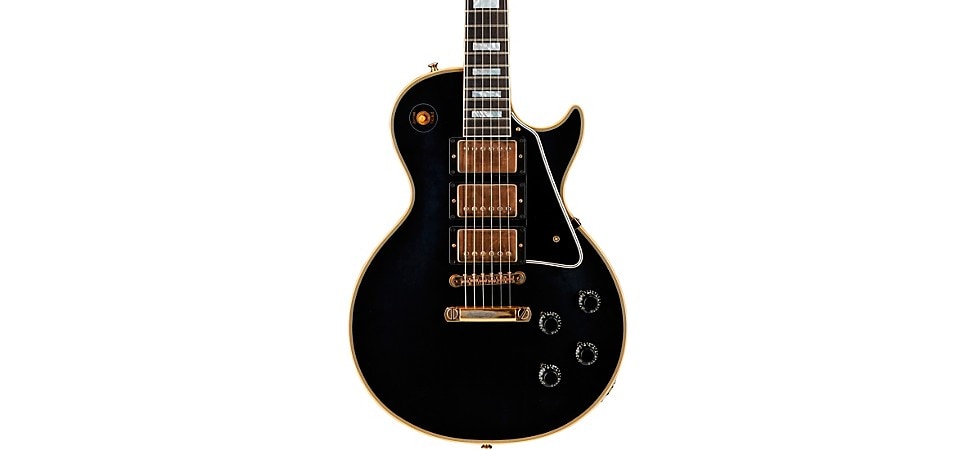
Pictured: Gibson Murphy Lab 1957 Les Paul Custom 3-Pickup Ulra-Light Aged Reissue
The Custom picked up a pair of nicknames: “Black Beauty” for obvious reasons, and “Fretless Wonder,” due to its having very low and flat frets. The Custom also featured Gibson President Ted McCarty’s final word on bridges with the ABR-1 Tune-O-Matic—where each string got its own saddle for precise intonation—and stopbar tailpiece. The groundbreaking design is still used today on countless instruments.
Of course, Paul continued to voice his opinion. He felt Gibson had “got it backwards”—that the less expensive Goldtop should have been manufactured with an all-mahogany body, and the elegant and more expensive Custom deserved the elaborate maple and mahogany tonewood combo.
Diversifying the Line: The Les Paul Junior, TV and Special
Gibson released two other guitars in 1954—the Les Paul Junior and Les Paul TV. The student-model Les Paul Junior came equipped with a single P-90, mounted "dog ear"-style with a screw at either end of the casing. The Les Paul TV was a shorter-scale version. The “TV” reference was based on its “limed mahogany” finish that stood out on black-and-white television broadcasts.
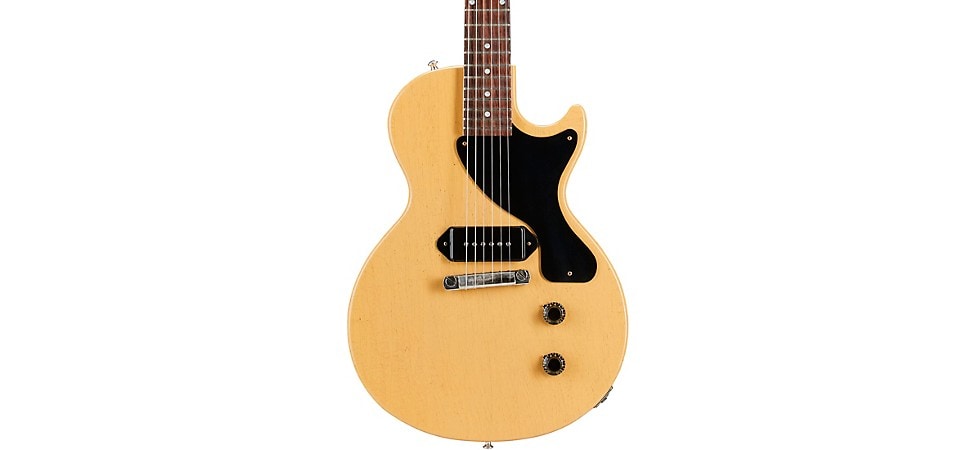
Pictured: Gibson Murphy Lab 1957 Les Paul Junior Single-Cut Reissue Ultra-Light Aged TV Yellow
The Les Paul Special appeared on the market in 1955. Loaded with a pair of P-90s and individual volume and tone controls, the Special had the same electronics as the Custom. It differed with a flat—not carved—top, which was Paul's preference.
Gibson gave customers an additional tailpiece option in 1956—a Bigsby vibrato unit. It worked well on everything from languid chord shimmers to raucous rockabilly rave-ups.
The Dawn of the P.A.F. Humbucker
In 1957, the Soviet Union got pole position in the space race with the launch of the Sputnik 1 satellite. Gibson had a technological marvel up its sleeve, as well, and it outlasted the USSR.
A new guitar pickup created by Lover in 1955 was dubbed a “humbucker,” as it “bucked”—or eliminated—the hum heard from P-90s and other single coils. Protective of this invention, Gibson affixed “Patent Applied For” stickers to dissuade others from copying the design.
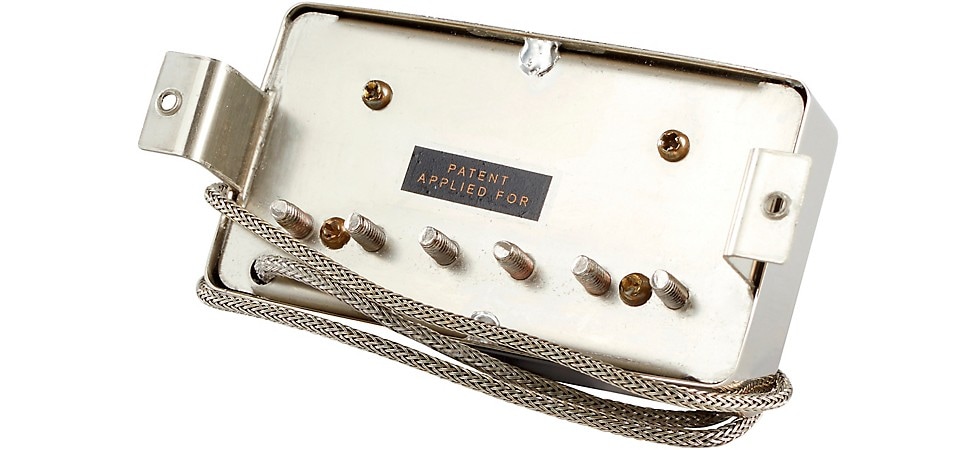
Pictured: Gibson '57 Classic Humbucker
First appearing on Gibson lap steels in 1956, the Les Paul became the first solidbody guitar line to feature the new P.A.F. humbuckers a year later. The ’57 Goldtop got a pair of P.A.F. pickups, and the ’57 Custom came with three. The sound produced was warm, rich and sweet. For example, Eric Clapton's tone on the Beatles’ "While My Guitar Gently Weeps" was pure P.A.F. The quality of the new humbuckers was such that P-90s were no longer offered on Les Pauls.
The Les Paul Standard Debuts
Despite the game-changing humbuckers, Gibson’s sales didn’t soar out of this world like the Sputnik. In 1958, the brand began phasing out the Goldtop, and gave the Les Paul a significant design change. Priced higher than the Goldtop, but less expensive than a Custom, the new Les Paul Standard featured plain maple tops and a cherry sunburst finish. Perhaps playing it safe as Les Paul sales began to wane, Gibson didn’t produce a vast number of Standards, and the model was discontinued in 1960.
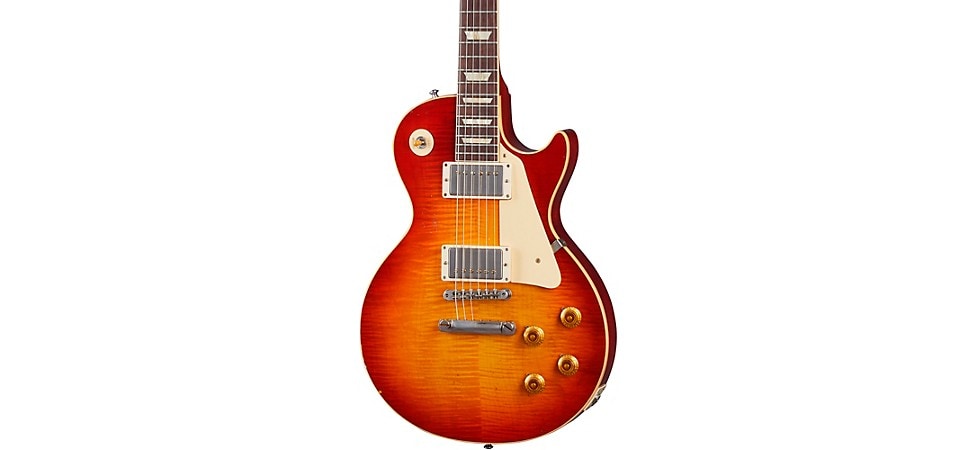
Pictured: Gibson Murphy Lab 1959 Les Paul Standard Reissue Light-Aged Cherry Teaburst
It’s an interesting comment on music and guitar culture that these once “undervalued” Standards—such as the 1958 and 1959 models—are so prized today. An all-original ’59 Standard, for example, can sell for the price of a house—up to $400,000 or more. Add a famous guitarist to the equation, and the sky’s the limit. In 2014, Metallica’s Kirk Hammett bought “Greeny”—a 1959 Les Paul Standard originally owned by Fleetwood Mac’s Peter Green, and later, Gary Moore—for just under $2 million.
No More Single-Cutaway Les Pauls
The “vintage” era of the single-cutaway Les Paul appeared to end in 1960, and perhaps Gibson felt two cutaways were better than one for the modern player. I mean, who really knows? But the Les Paul brand was now populated with the flat-topped, sharp-horned Les Paul SG, Les Paul SG Junior, Les Paul SG TV, Les Paul SG Special and SG Les Paul Custom. In 1963, the “Les Paul” was dropped from the model name, and the guitars became, simply, SGs. (By the way, if you don’t already know, “SG” stands for “Solid Guitar.”)
Les Paul—the player—was not a fan of the SG, although he remained contractually bound to play them.
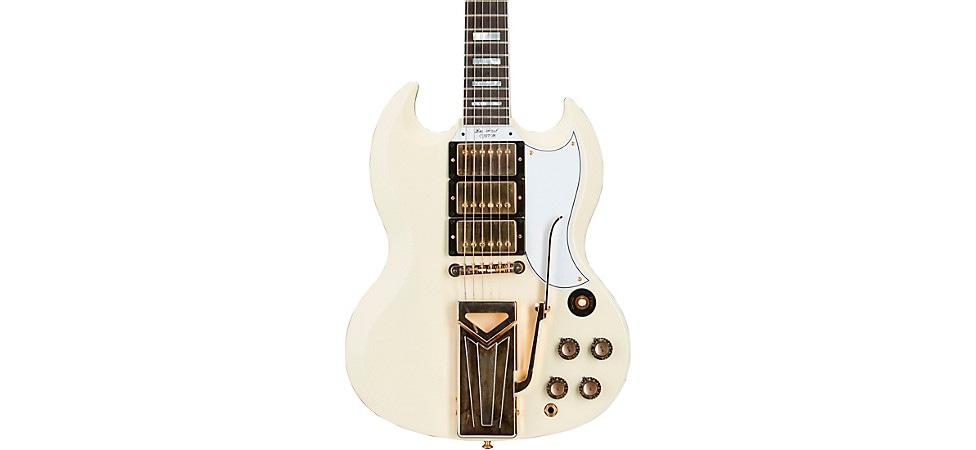
Pictured: Gibson 60th Anniversary 1961 Les Paul SG Custom VOS Classic White
“The neck was too skinny, and I didn’t like the way it joined the body—there wasn’t enough wood,” he told author Tom Wheeler for his book American Guitars. “I called Gibson and told them to take my name off the thing.”
But this, too, may not be the whole story.
Paul and Ford were immersed in a bitter divorce around 1963, and allegedly Paul felt fortunate that his Gibson contract ended in 1962. If he signed a new endorsement—and revenue share—contract during the divorce proceedings, he feared Ford’s lawyers would demand the estimated earnings from the new deal be added to the divorce settlement. As Paul’s live appearances and recording successes diminished during this period, Gibson likely saw little business advantage in retaining the endorsement, as well.
The Les Paul Comes Back
By 1963, any psychic worth their mystic sight would have predicted the Les Paul legacy was done. But not so fast …
We can thank the enduring British Invasion—the musical one—for reviving an America classic.
Keith Richards of the Rolling Stones famously played a ’59 sunburst Standard outfitted with a Bigsby. Jimmy Page’s “number one” in Led Zeppelin was a ’58 Standard. Eric Clapton’s love for blues icon Freddie King prompted him to adopt the Les Paul, and he played a 1960 Standard on the revolutionary 1966 album, Blues Breakers with Eric Clapton. Paul McCartney even acquired lefty Les Pauls—a 1957 Goldtop and a 1960 Standard.
More British—and American—players joined the Les Paul parade, including Peter Green (who wielded the famous “Greeny” now owned by Metallica’s Kirk Hammett), Paul Kossoff, Jerry Garcia, Mike Bloomfield, Neil Young and others. Not surprisingly, popular demand compelled Gibson to bring back the traditional Les Paul in 1968.
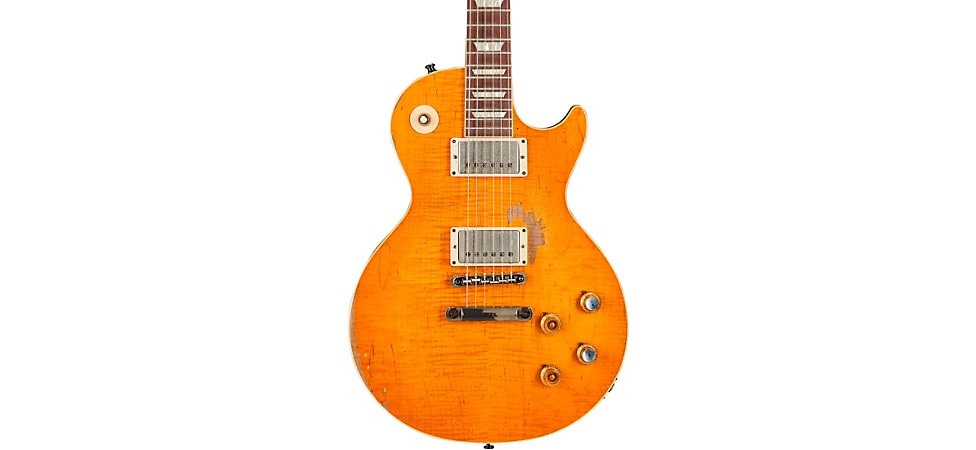
Pictured: Gibson Murphy Lab Kirk Hammett Greeny 1959 Les Paul Standard
The initial reissue was the Les Paul Standard. Strangely, it was not offered with P.A.F. humbuckers, appearing instead with Goldtop specs and P-90 pickups. It still had plenty of mojo, though. Boston’s Tom Scholz played a ’68 on "More Than a Feeling" and other hits. The Les Paul Custom also returned in 1968 with a carved maple top—not mahogany—and two humbuckers. A new model, the Les Paul Deluxe, was introduced in 1969 with mini humbuckers.
The Norlin Era of Gibson
In yet another example of guitar business synergy, Fender had its CBS era (1965–1985) and Gibson experienced its Norlin years (1969–1986). Hang on to your fashionable hats, because the corporate maneuvers are going to get twisty. Gibson’s parent company CMI (Chicago Musical Instruments, which bought the brand in 1944) was acquired by South American brewing corporation, Ecuadorian Company Limited, in 1969. ECL morphed into Norlin Corporation the same year. (The name represents ECL president Norton Stevens and CMI boss Arnold Berlin—Nor-Lin.) CMI continued to manage—at least, nominally—Gibson operations until 1974, when the company became a full subsidiary of Norlin Musical Instruments.
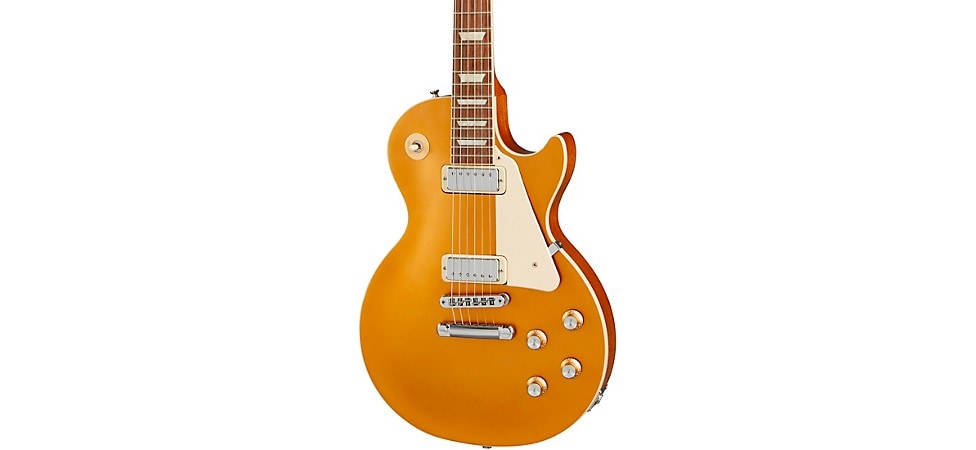
Pictured: Gibson Les Paul Deluxe '70s Gold Top
Fair or not, Gibson’s Norlin years are often viewed with the same suspicion and controversy that Fender fans attribute to that brand’s CBS era. Changes in manufacturing did occur, of course—some to reduce costs and maximize profitability, and others (pickup cavity shielding, reinforced upper-neck volutes, etc.) to enhance existing models.
Perhaps the biggest shock for Gibson devotees was Norlin’s moving production away from the Kalamazoo, Michigan plant in the city where Gibson was founded in 1894. From 1976 to 1984, manufacturing shifted to Nashville, Tennessee, and the Kalamazoo factory was closed for good in 1984.
Changes to the Gibson Les Paul in the Norlin Years
There were six key changes to the classic Les Paul platform while Norlin owned Gibson. In addition, there was a crafty repurposing of the Les Paul silhouette to some other models, such as the L6-S (which Carlos Santana endorsed as his tonal “rainbow”), the Sonex (bearing a synthetic “Resonwood” body and a bolt-on neck) and the S-1 (featuring three Bill Lawrence-designed single coils). As for the alterations to the actual Les Paul design, here’s what transpired …
|
Feature |
Pre-Norlin |
Norlin |
Player Benefit or Cost Cutting |
Ramification |
|
Body |
One-piece mahogany |
Crossbanded with thin sheets of mahogany and maple bonded together |
Both |
Minor tonal difference. Norlin Les Pauls still sound like everything we love about Les Pauls. |
|
Headstock |
Vintage |
Larger |
Both |
Mostly aesthetic. Do you dig Doc Martens boots or Vans Slip-Ons? |
|
Top |
Two-piece maple cap |
Three-piece maple cap |
Cost cutting |
Say goodbye to exquisitely bookmatched, two-piece maple tops. |
|
Neck |
One-piece mahogany |
Three-piece maple |
Player benefit |
Three-piece necks are more stable. Tonal consideration: Mahogany is warm with good sustain; maple is articulate with less sustain. |
|
Volute |
N/A |
Volute carved into bottom of headstock |
Uncertain |
Norlin attempted to solve headstock breakage problem, but effectiveness is still debated. |
|
Bridge |
ABR-1 (slim) |
Nashville (thicker) |
Player benefit |
Nashville version offers wider saddle adjustment, but ABR-1 is still vintage cool |
Les Paul Returns With Les Paul Recording Model
Let’s take our time machine back to 1969, when Les Paul was back working with Gibson. The “homecoming” was auspicious for a number of promotional and strategic reasons, and it also provided Paul with the opportunity to design the guitar he really wanted to make.
“I gave Gibson all of my secrets,” he said.
The result was the Les Paul Recording in 1971. It had a lot of controls to accommodate Paul’s never-ending quest for tone, and it came with low-impedance pickups to deliver the pristine clean sounds he obsessed over.
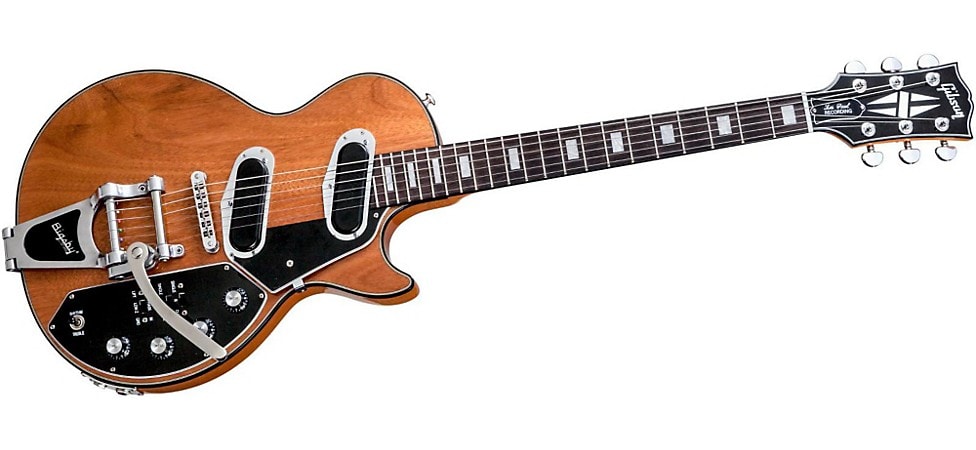
Pictured: Gibson Les Paul Recording Reissue
But, genius that he was, Paul misread the room.
Designed mostly for recording direct through a mixing console, the Les Paul Recording was absolutely the right guitar for a man who was still making tracks in his home studio, still working to “perfect” the sound of the guitar (to his standards, of course), and still tinkering with electronics that could wring every nuance from his fingertips.
However, that wasn’t exactly what ’70s guitarists were going for. They were using Les Pauls armed with high-impedance humbuckers to produce crunchy rhythms, soaring and distorted lead tones and general overdriven mayhem. After reaching a pinnacle of 1,759 Les Paul Recording models shipped in 1973, by 1979, the number had slipped to just 78, and Paul’s dream studio guitar was discontinued.
“The Les Paul Recording guitar didn’t sell because the kids were into overdriving the input of their amps to get distortion,” said Paul, realizing too late the preferences of the guitarists who were inventing classic rock. “And to get the pleasant distortion they wished to hear, the pickup has to brutally hit the first stage of the amplifier.”
The No-Frills Les Paul Studio
Toward the end of Norlin’s ownership in 1983, Gibson realized there was a market desire for a lower-priced Les Paul, and they had nothing in their lineup to attract that customer. The company came up with the Les Paul Studio, delivering all of the guitar’s iconic sound, but removing much of the cosmetic flair. In fact, the “Studio” name was a reference—that no one would be able to tell from the sounds tracked in the hidden confides of a recording facility—that a player was using anything different from a much more glam Les Paul Standard or Les Paul Custom.
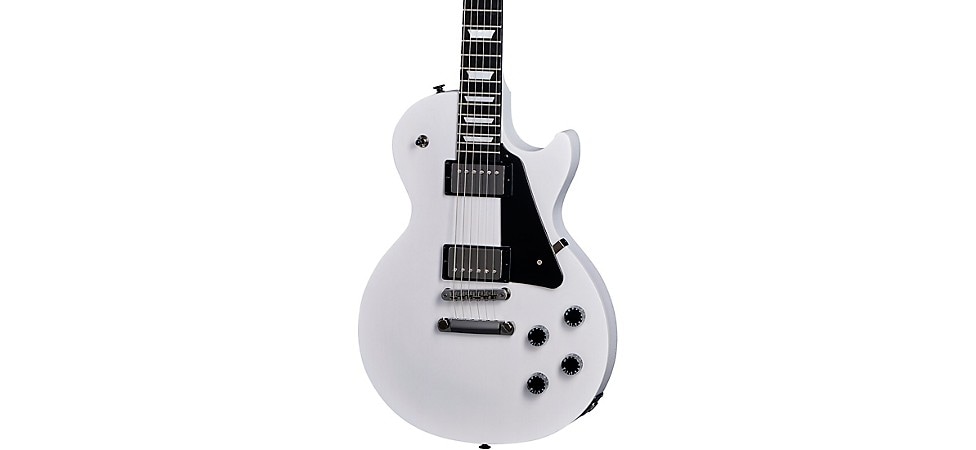
Pictured: Gibson Les Paul Modern Studio Worn White
Gibson in the Modern Era
Much like the unpredictability of early Les Paul sales, Gibson faced challenges in the 1980s. In fact, after posting less than $10 million in sales during 1985, the company was said to be three months away from going out of business. Just in time, Gibson was purchased by Henry Juszkiewicz, David Berryman and Gary Zebrowski in January 1986—reportedly for $5 million. Under Juszkiewicz’s leadership, there was a focus on innovation and acquisition—usually of music-tech companies—as well as the development of the Gibson Custom Shop and highly accurate VOS (Vintage Original Spec) builds.
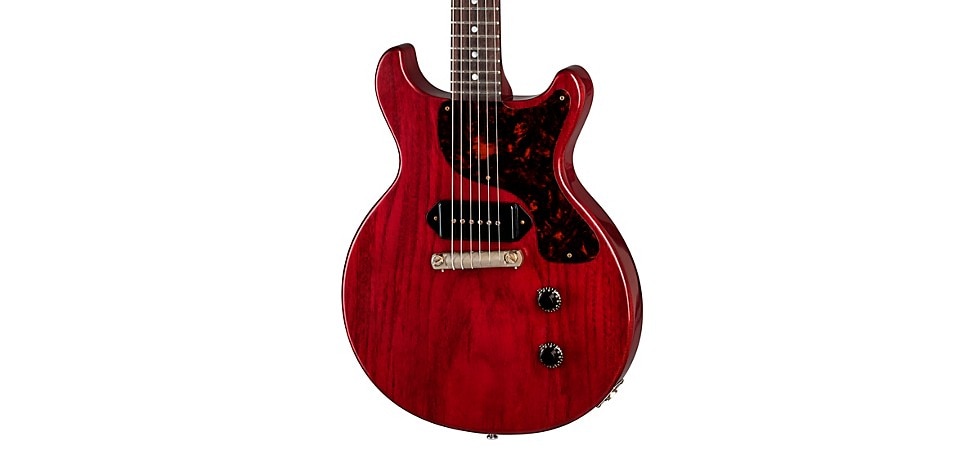
Pictured: Gibson 1958 Les Paul Junior Double-Cut Reissue VOS Faded Cherry
While Juszkiewicz and his team had saved Gibson, business, cultural and community perception challenges plagued the brand, and it filed for Chapter 11 bankruptcy protection in 2018. That same year saw Gibson acquired by KKR & Co., and Juszkiewicz stepped down. Under new leadership, the revitalized Gibson Brands immediately returned to its core business of building high-quality instruments. In addition, the company opened its stunning flagship Gibson Garage in Nashville in 2021, and expanded the concept to London in early 2024.
“Owning guitars from the golden era led by Ted McCarty and his team gives me an appreciation of Gibson’s heritage and history, as well as what they were doing and how that influenced music across so many genres,” said current Gibson President and CEO Cesar Gueikian, who has a massive personal guitar collection. “For example, I’ve played probably 20 or 25 Les Paul Standards from 1959. They’re all different, but you kind of fall in love with every one you play. I think that now we are making the closest clones of ’59 Les Paul Standards in the history of the Gibson Custom Shop.”
An Enduring Legacy
Today, Gibson is enjoying a renaissance, producing accurate replicas of vintage Les Pauls in the regular lineup and Custom Shop, aged “new vintage” marvels from its Murphy Lab, signature model Les Pauls and Modern Les Pauls with features and playability for current players. And, if you’re on the hunt for an actual vintage Les Paul, try searching Guitar Center’s Vintage Les Paul Collection.
“There are a lot of fine points that speak to the Les Paul’s longevity,” Paul told Guitar Player in July 2002, “But the most important factor is its beauty. It has a beautiful look and a beautiful sound. A Les Paul is your best friend and your partner—it’s everything to you. You can’t find a more gorgeous instrument. The others are just planks of wood.”


